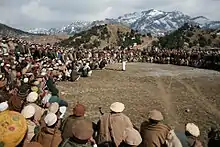
The Bettani (Pashto: بېټني), also spelled Baittani or Bhittani, is a Pashtun tribe located mostly in Afghanistan and Pakistan. The Bettani are named after Shaykh Beṭ,[1] their legendary ancestor, who is said to be the second son of Qais Abdur Rashid. The Bettanis are Sunni Muslims of the Hanafi school. The Bettani confederacy includes the tribes of Bettanis, and the Matti tribes, which are the progeny of BiBi Mattu, the daughter of Sheikh Bettan. These include the Lodi, who are also known as Lohani, as well as the tribes of Marwat, Tanoli, and Niazi. The Shirani tribe has also been referenced as a component of the Bettani confederacy.[2][3]
History
According to Makhzan-e-Afghani, a compiled history of Afghans written by Ni'mat Allah al-Harawi, the Bettani are said to be named after their ancestor Betṭ Baba (claimed by a legend to be the first Pashto poet), who lived in the Altamur range, which is located between Logar and Zurmat. The narrative continues with the account of his burial in Ghazni.[4]
The Bettani are also known to have lived in the Logar, Zurmat and Ghazni areas of Afghanistan until the 15th Century. However, this period saw them embroiled in conflicts with the Ghilji group. The Bettanis were eventually compelled to vacate these areas, moving towards the east. Among Bettanis, some managed to secure control over Gabarḡar, situated between the Bannu Basin and Dēra, while other segments of the Bettani lineage migrated further northeastward..[5][1]
Settlements
Some Bettanis reside in Pakistan, in Tank and Lakki Marwat. Jandola is considered the capital of the Bettani tribes.[6][7] The area is mainly inhabited by the Bettanis. They also inhabit Dera Ismail Khan and Bannu, mostly in the mountainous areas on the borders of Tank and Bannu, from the Gabbar mountain in the north to the Gomal valley in the south.[5][8]
During the reign of the Lodi dynasty, some Bettanis had prestigious positions, and many of them served in the Sultanate's army.[9]
Tribal organization
The Bettani tribe is divided into four subgroups: Tattao (mostly living in Jandola, Siraghar, and Dera Ismail Khan), Bakhtiyari (living throughout Pakistan and in Petlad, Gujarat), Dhanna (living on the Gabbar mountain and in Lakki Marwat District), and Waraspun (living in Dera Ismail Khan and nearby valleys). Lakki Marwat District is also inhabited by the Boba, Bobak, and Wargara clans of the Bettanis.[7]
The Tattao are subdivided into three clans: the Umarkhail, the Aba Khel, the Naimat Khel, and the Khaishi. The Dhanna are divided into the Ali Khail, the Rattanzai, the Bobi, the Waroki, and the Dadi Khel subclans. The Waraspun are divided into the Mazyani, the Tari, the Chapli, and the Shakhi clans.
The Bettani have historically had a low population, increasing from 8,000 – 9,000 in c. 1884 to over 43,000 by c. 1960. Currently, the Bettani tribe numbers between 200,000 and 250,000.[8]
Bettani Sufi saints
The Shrine of Mama Peer is located near the town of Umar Adda. Some people in the area visit the shrine on a daily basis, particularly on Friday. Many devotees also visit the shrine the of the Sufi saint Sheikh Younas, situated near Jandola.[5]
Notable people
References
- 1 2 Balland, Daniel. Encyclopædia Iranica. BĒṬANĪ. Originally published on 15 December 1989.
- ↑ History of Afghans by Dorn B.
- ↑ Bet Sheikh شېخ بېټ نيکه.[usurped] Khyber.ORG.
- ↑ Makhzan-e-Afghani
- 1 2 3 Gazetteer of Bannu
- ↑ Hayat e Afghan
- 1 2 Castes of Punjab by Ibettson
- 1 2 The Pathan Boderland, Spain
- ↑ Makhzan-e- Afghani
Further reading
- Muntazir Bettani Poetry book Kuthab stuarey
- Historical Pashtu book written by Sohail Bettani "De Bettanu Tarikh" (History of Bhittani Tribe)
- The Batani, Baitani or Bhittani 1935) "Powindah Bhittani" Notes on Nomad Tribes of Eastern Afghanistan Government of India Press, New Delhi, India, page 158.
- Daniel Balland
- Encyclopædia Iranica
- Sulaiman Maku Book Tazkerat Al Awliya (Memoirs of Saints) (612 Hijera, 1216 AD) edited and annotated by Abdul Hai Habibi